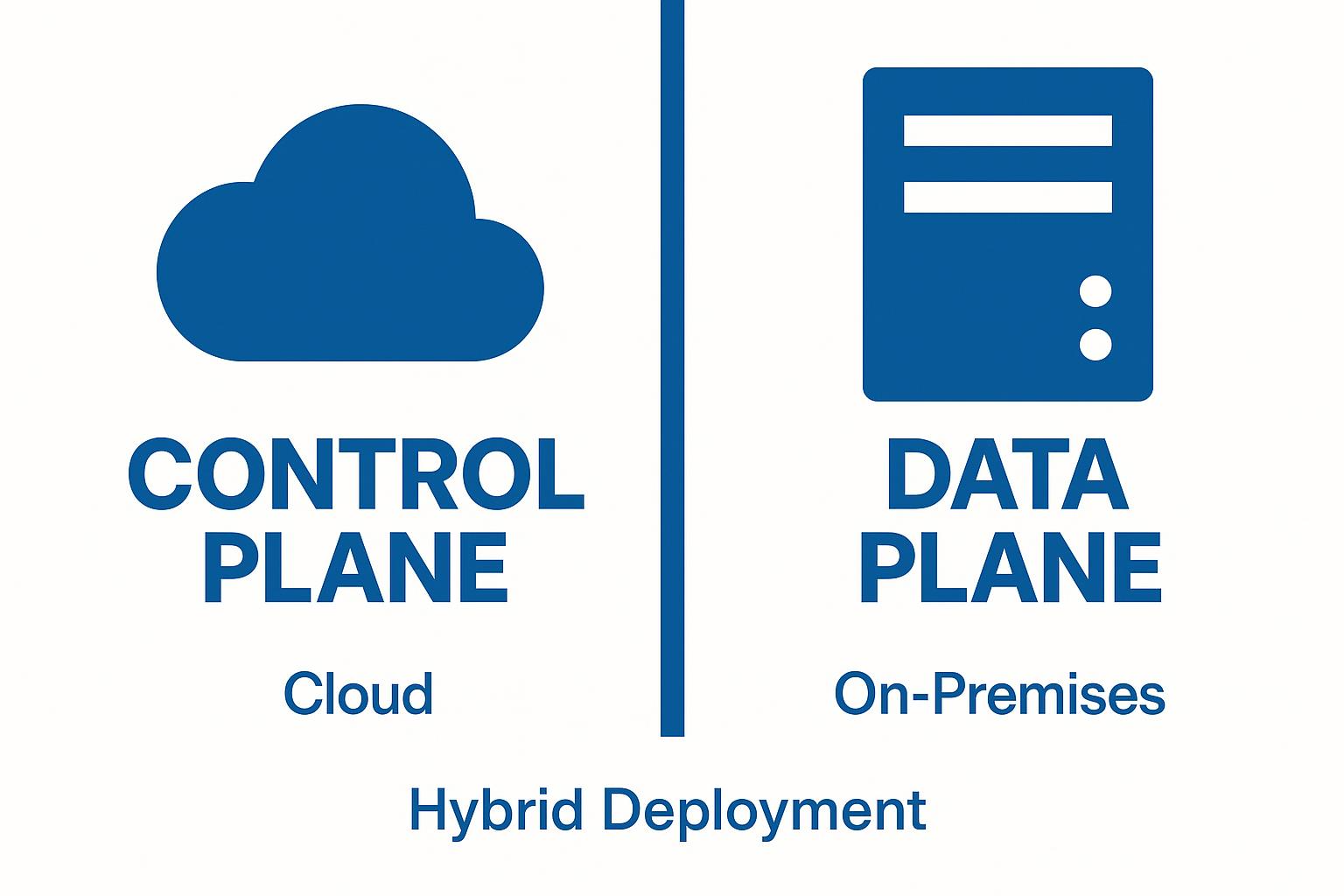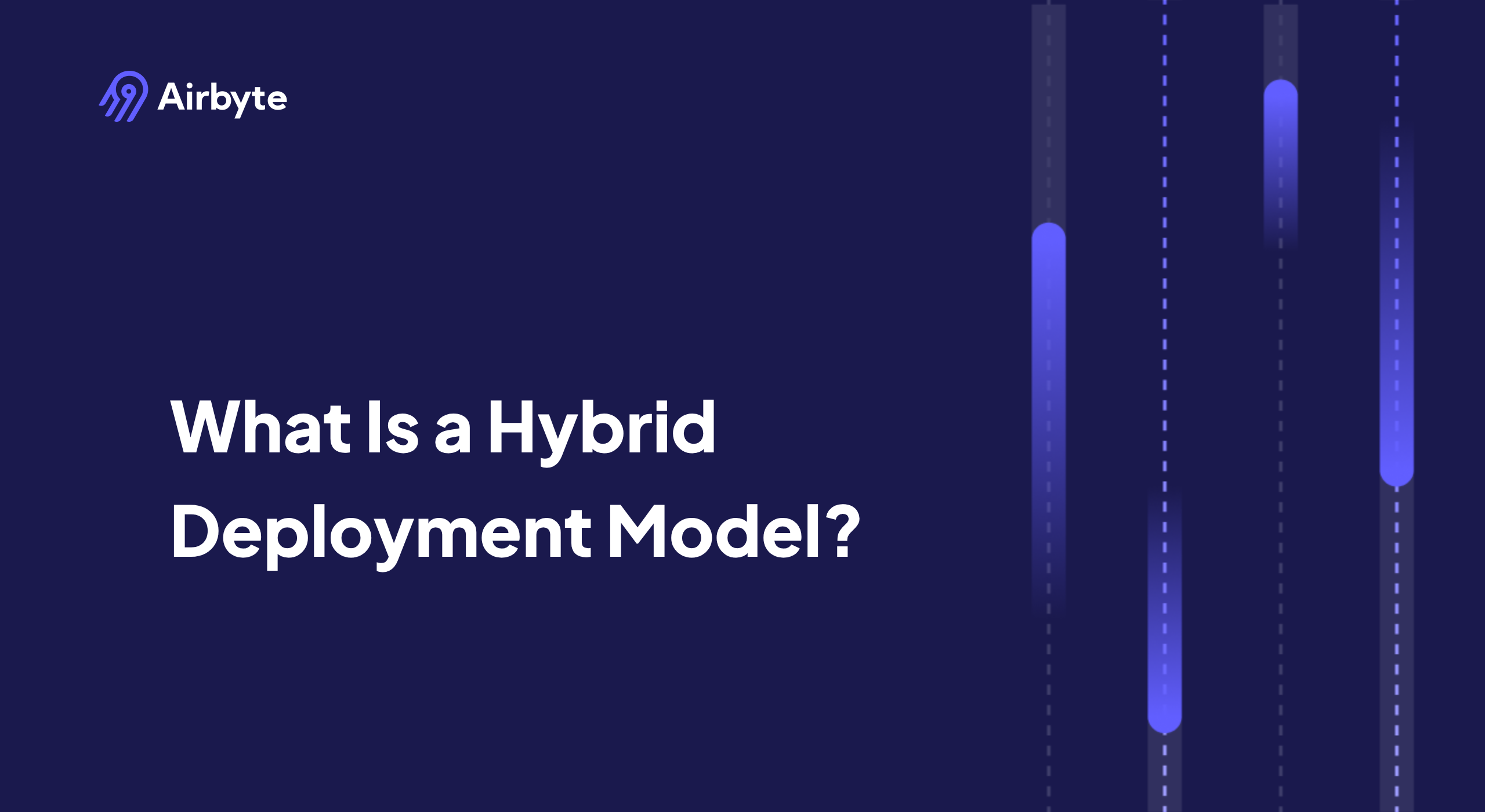What Is a Hybrid Deployment Model?
Summarize this article with:
✨ AI Generated Summary
Enterprises working under GDPR, HIPAA, or EU DORA face a stubborn dilemma. You want the elasticity of the cloud, yet auditors often insist (based on their interpretation of compliance) that critical data should remain within secured networks. A hybrid deployment model resolves that tension by keeping the data plane (where records are stored and processed) inside your VPC or data center while shifting the control plane to a managed cloud service.
This separation gives you centralized orchestration without surrendering custody of sensitive information. The result is a single, unified system that scales like SaaS but preserves on-premises sovereignty. Hybrid deployment lets regulated teams innovate at cloud speed without breaking compliance.
What Exactly Is a Hybrid Deployment Model?
Rather than traditional cloud-versus-on-premises thinking, a hybrid deployment model creates a single platform deployed across two strategic locations. The management brain (the control plane) runs in the cloud, while the muscle (the data plane) lives inside your own network or VPC. This architecture delivers cloud-grade orchestration without letting sensitive data leave your environment.

Key components include:
- Control plane in the cloud: Handles provisioning, scheduling, monitoring, and policy enforcement through public APIs for creating pipelines or updating configurations
- Data plane in your environment: Runs the actual connectors and transformation tasks next to your databases, keeping credentials and records under your jurisdiction
- Shared codebase: Both planes follow a unified codebase, acting as one system rather than two parallel stacks with a single UI, API set, and connector library
- Execution location flexibility: Only the execution location changes between deployments, not the functionality or features
This distinction separates modern hybrid deployment from traditional hybrid cloud solutions, where entire applications are simply split between public and private infrastructure. Here, you maintain the operational simplicity of the cloud while meeting the sovereignty and compliance demands that pure cloud deployments can't satisfy.
How Does a Hybrid Model Work in Practice?
The communication architecture between control and data planes determines hybrid deployment success. The control plane, residing in the cloud, handles resource provisioning, scaling, and overall orchestration through outbound-only communication to the data plane. This greatly reduces inbound threat vectors while enabling centralized cloud orchestration for seamless updates and monitoring.
Data processing occurs locally in the data plane, where sensitive operations are handled securely within your organization's firewall. This ensures data sovereignty and compliance with regulatory requirements while maintaining performance efficiency through proximity to source systems.
Understanding the distinct roles of each plane clarifies this architectural separation:
Securing communication between these planes involves employing technologies such as VPNs and dedicated connections, ensuring encrypted data transfers. Workloads can dynamically shift between environments based on demand, ensuring performance efficiency while maintaining security boundaries.
What Are the Core Benefits of Hybrid Deployment?
Separating control-plane logic in the cloud from a data plane in your environment solves specific operational problems that pure cloud or pure on-premises approaches create. The hybrid model addresses real workload constraints, especially for regulated industries that can't afford compliance surprises.
Data Sovereignty
Data sovereignty ensures that data and credentials never leave your VPC or on-premises infrastructure. You maintain full jurisdictional control over sensitive records, satisfying GDPR data-transfer requirements and EU DORA operational resilience mandates. The public cloud sees only telemetry data, not customer records, giving auditors clean separation of duties without additional compliance tooling.
Managed Efficiency
Managed efficiency transforms operations by handling upgrades, monitoring, and scaling through the cloud control plane. No support tickets, no midnight maintenance windows. You run lightweight data plane components locally while the provider handles connector updates and health monitoring centrally, reclaiming engineering hours previously spent on cluster patching and version management.
Compliance Confidence
Compliance confidence keeps regulated data on local systems where you enforce HIPAA encryption or GDPR deletion policies directly. Cloud-based policy engines maintain centralized RBAC and audit logs, streamlining evidence collection during compliance reviews. Financial services teams use this pattern to meet DORA operational continuity requirements without duplicating security controls across environments.
Flexibility for Growth
Flexibility for growth starts with one on-premises database and a few cloud analytics destinations, then scales to cloud resources during traffic spikes without rewriting data pipelines. When latency or egress costs change, you move workloads, not architecture. Public cloud handles unpredictable demand while your private infrastructure manages steady-state operations.
Unified Experience
Unified experience eliminates the complexity of managing two separate products. A shared codebase delivers the same connector library, identical API calls, and consistent observability whether jobs run in AWS or your data center. This consistency reduces operational overhead by eliminating duplicate runbooks and decreasing troubleshooting time when issues occur.
The result is a system that keeps data local, operations simple, and attack surfaces minimal while maintaining the capacity to scale when business demands require it.
Who Benefits Most from a Hybrid Deployment Model?
Hybrid deployment works best for organizations that handle sensitive data while needing real-time analytics capabilities. The biggest impact shows up in regulated industries where data sovereignty requirements clash with modern infrastructure needs.
Why Does Airbyte Enterprise Flex Define the Hybrid Standard?

Effective hybrid architecture requires a clear split between management logic and data processing. Airbyte Enterprise Flex follows this principle with a "cloud control plane, customer-controlled data plane" design, mirroring the fault-isolated pattern. You get cloud orchestration without opening a single inbound port to your VPC or on-premises servers.
Key features include:
- Unified codebase across all deployments: Every deployment runs on the same open-source codebase, so you never sacrifice features when you keep data local
- Full connector catalog everywhere: The complete catalog of 600+ connectors, the scheduling engine, and quality enforcement tests ship unchanged across Airbyte Cloud, Self-Managed Enterprise, and Flex
- Workload portability: Your team can move workloads between environments or mix them without rewriting pipelines or retraining staff
- No feature compromises: Other "hybrid" solutions still require manual agent patching or accept reduced connector coverage, but Flex eliminates both problems
Flex addresses the sovereignty, compliance, and operations trade-offs discussed throughout this analysis. Sensitive records stay behind your firewall for GDPR or HIPAA audits, while upgrades, monitoring, and scaling remain Airbyte's responsibility. This approach lets you focus on delivering data products instead of maintaining integration infrastructure.
Why Choose Hybrid Deployment for Your Data Infrastructure?
Hybrid deployment models deliver cloud-grade agility without surrendering data control through strategic separation of control plane management and data plane processing. This architecture satisfies GDPR, HIPAA, and DORA requirements while enabling global scale, making it essential for regulated industries that refuse to compromise on either compliance or innovation.
Airbyte Enterprise Flex exemplifies this approach with unified tooling across environments, proving that you can have both sovereignty and scalability in modern data infrastructure. Explore Airbyte's 600+ connectors with unified AI-ready quality across cloud, hybrid, and on-premises. Talk to Sales about your hybrid deployment requirements.
Frequently Asked Questions
What Are the Security Implications of Hybrid Deployment?
Hybrid deployment strengthens security posture through architectural separation. The data plane processes sensitive information behind your firewall while the control plane manages orchestration through outbound-only connections, eliminating inbound network ports to your environment. Your security team maintains direct control over data access policies, encryption standards, and compliance frameworks without depending on vendor security models.
How Does Hybrid Deployment Compare to Fully Managed Cloud Solutions?
Fully managed cloud solutions process data in vendor infrastructure, which creates compliance challenges for regulated industries. Hybrid deployment keeps data processing in your environment while delivering cloud management benefits, avoiding the operational overhead of fully self-managed systems. This architectural difference proves critical for organizations where data residency is non-negotiable, yet cloud scalability and managed updates remain essential for operational efficiency.
What Infrastructure Requirements Does Hybrid Deployment Need?
Hybrid deployment requires compute resources in your environment to run the data plane, typically using Kubernetes clusters sized based on data volume and connector count. Network connectivity between your data plane and the cloud control plane requires stable internet access with TLS encryption, with many organizations using AWS PrivateLink or VPN connections for additional security. Your infrastructure team maintains control over scaling, backup strategies, and disaster recovery procedures.
Can You Migrate Between Deployment Models Without Rewriting Pipelines?
Modern hybrid platforms built on unified codebases enable migration between deployment models without pipeline rewrites. You can start with cloud deployment, then move to hybrid as compliance requirements evolve, or shift specific workloads between environments based on data sensitivity. The key is choosing platforms where control plane and data plane share identical connector implementations, enabling teams to move workloads in days or weeks through configuration changes rather than code rewrites.

.webp)
